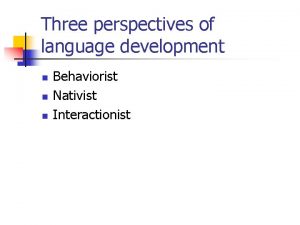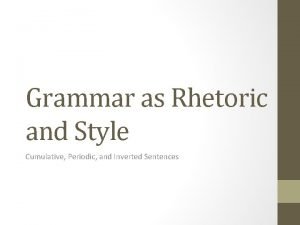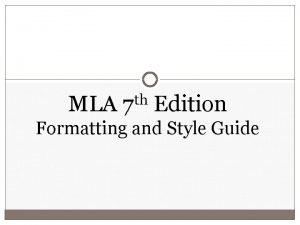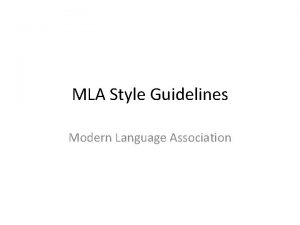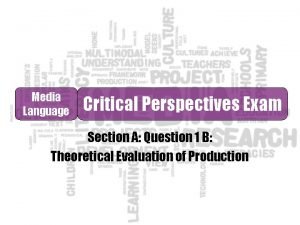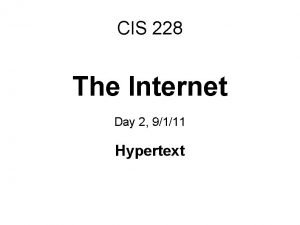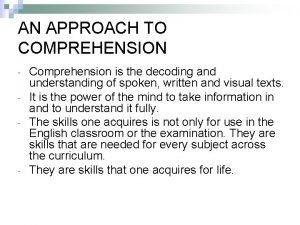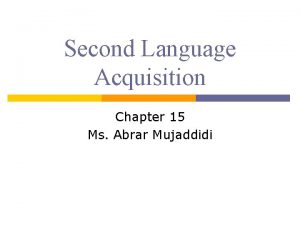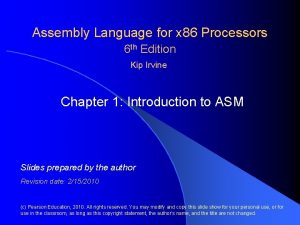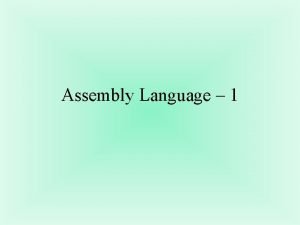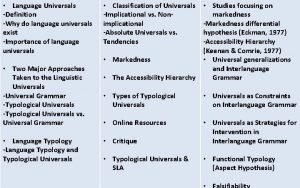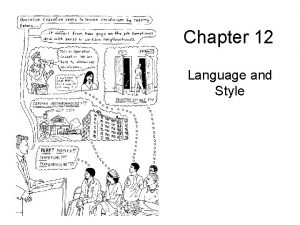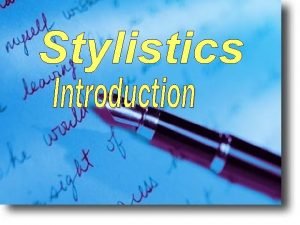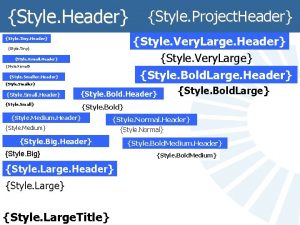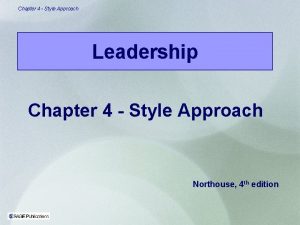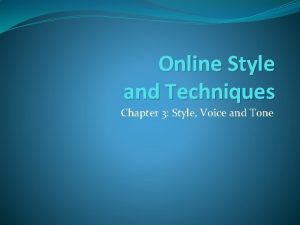Chapter 12 Language and Style Language and Style

































- Slides: 33

Chapter 12 Language and Style

Language and Style: Introduction • Word choice (diction) requires consideration of audience, occasion, and nature of message. • Well-chosen words can make a speech clear and memorable. • Speakers can confuse some listeners through unconsidered word choice.

Language and Style: An Overview • This chapter examines: – The importance of language and word choice – Differences between oral and written language – Denotative and connotative meaning – Presenting your message clearly – Expressing your ideas effectively – Choosing respectful and unbiased language

The Importance of Language and Word Choice • Words convey ethos to listeners. – Using language appropriately can give your credibility a boost. – Choosing the right words clarifies your message.

The Importance of Language and Word Choice

The Importance of Language and Word Choice

Differences Between Oral and Written Language • Oral language is more adaptive. – Writers do not get immediate feedback from a live audience. – Speakers can respond as they receive feedback.

Differences Between Oral and Written Language • Oral language tends to be less formal. – Written language lends itself to precise word choice and formal grammar. – Spoken language lends itself to a simpler, more conversational tone.

Differences Between Oral and Written Language • Oral language incorporates repetition. – Writing teachers advise students to avoid redundancy. – Listeners can’t go back and revisit points in a speech, therefore, repetition is a useful tool.

Denotative and Connotative Meaning • Denotative meaning is an exact, literal dictionary definition.

Denotative and Connotative Meaning • Connotative meanings are the various associations that come to mind when we hear or read a word.

Tips for Denotative and Connotative Meaning • Tip: Using a word without considering its multiple meanings can backfire and confuse. • Tip: Be sure to consider your audience’s connotations for important words.

Presenting Your Message Clearly: Understandable Language • Use language your listeners recognize. • Analyze your audience to determine appropriate word choice. • Avoid technical terms and specialized jargon. – If you can say something in plain language, do so. – If you do use jargon, explain it.

Presenting Your Message Clearly: Understandable Language

Presenting Your Message Clearly: Concrete Words • Choose words that are concrete, or specific. • Abstract words that are general can confuse. • Use abstract words to give the big picture. • Use a mix of concrete and abstract words as needed.

Concrete Words vs. Abstract Words

Presenting Your Message Clearly: Proper Use of Words • Using incorrect terms: – Undermines clarity and credibility – Can create unintended humorous consequences – Example: “recession” instead of “depression”

Presenting Your Message Clearly: Proper Use of Words

Presenting Your Message Clearly: Concise Language • Each sentence should express one thought. • Remember: Long sentences may be clear in print, but listeners only get one chance to hear spoken words.

Presenting Your Message Clearly: Concise Language • Avoid verbal clutter, extraneous words that confuse your audience. • Example: – Cluttered: “Regardless of the fact that you disagree with the government’s position, you cannot dispute the FCC’s ruling. ” – Uncluttered: “Although you disagree with the government’s position, you cannot dispute the FCC’s ruling. ”

Expressing Your Ideas Effectively: Repetition • Repeating a word or phrase can draw listeners’ attention and leave lasting memories. • Repeating words later in speech can remind the audience of previous points. • Rewording potentially confusing passages is a form of repetition.

Expressing Your Ideas Effectively: Repetition

Expressing Your Ideas Effectively: Hypothetical Examples • Imagined scenarios that help listeners follow complicated points such as policy statements.

Expressing Your Ideas Effectively: Personal Anecdotes • Personal stories build credibility and reassure listeners you are not judging them. – Show that you take a subject seriously – Can help avoid causing offense on sensitive subjects

Expressing Your Ideas Effectively: Vivid Language • Vivid language grabs attention by appealing to the five senses. • Stronger imagery creates deeper impressions on an audience. • Overuse of vivid language may diminish effectiveness.

Expressing Your Ideas Effectively: Figurative Language • Similes and metaphors both suggest similarities between objects that are not alike. • Similes make explicit comparisons with like or as. – Example: After bumping her head, she fell like a tree. • Metaphors make implicit comparisons. – Example: Her life was a journey along a path filled with obstacles.

Tips for Using Similes and Metaphors • Tip: Be sure the comparison makes sense. • Tip: Avoid mixing comparisons.

Choosing Respectful and Unbiased Language • Biased language: Suggests prejudice or preconceptions about other people – Erodes speaker’s credibility – Distracts audience from listening to your message

Choosing Respectful and Unbiased Language: Avoid Stereotypes • Stereotypes: Generalizations based on the false assumption that characteristics displayed by some members of a group are shared by all members of that group. – May be based on ethnicity, race, gender, religious beliefs, sexual orientation, socioeconomic background, and so on – Represent biased language • Stereotyping also occurs when speakers make claims beyond the facts that their evidence proves. �

Choosing Respectful and Unbiased Language: Use Gender-Neutral References • Some word choices reinforce genderbased stereotypes. – Examples: cleaning lady, fireman • Select gender-neutral terms, where possible. – Use plural forms of words (presidents, employees). – Choose words that do not indicate gender (firefighter, chair, poet).

Choosing Respectful and Unbiased Language: Make Appropriate References to Ethnic Groups • Use the noun preferred by a particular ethnic group when referring to that group. – African American instead of black • Refer to ethnic groups correctly. – A person form Nigeria is not African American. • Use masculine and feminine forms of words correctly. – Ana Castillo is a Chicana, not a Chicano.

Choosing Respectful and Unbiased Language: Steer Clear of Unnecessary References to Ethnicity, Religion, Gender, or Sexuality • Do not mention a person’s ethnicity, religion, gender, or sexuality if it’s irrelevant to your point. – Doing so will hurt your credibility.

Choosing Respectful and Unbiased Language: A Note on Appropriate Language and Political Correctness • Words have tremendous power. – Avoid words that could cause harm or pain to others, when possible. • Guidelines on word choice may restrict rights to freedom of expression. – Enforced “political correctness” • Avoid the “PC debate” by supporting your position with credible evidence and logical reasoning.
 Modified block style letter format
Modified block style letter format Casual tone
Casual tone Formal v informal writing
Formal v informal writing Nnn speech
Nnn speech Inversion in poem
Inversion in poem Cumulative sentence
Cumulative sentence Chapter 9 voices and instrument families
Chapter 9 voices and instrument families Winter dreams literary analysis
Winter dreams literary analysis Language font style
Language font style Googegg
Googegg Language font style
Language font style Language font style
Language font style Language font style
Language font style Language font style
Language font style The handmaid's tale citation mla 8
The handmaid's tale citation mla 8 Paradise lost lecture
Paradise lost lecture Language font style
Language font style Language font
Language font Figurative language in othello
Figurative language in othello Language font style
Language font style Language techniques
Language techniques Style chapter 1
Style chapter 1 Second language vs foreign language
Second language vs foreign language Difference between second language and foreign language
Difference between second language and foreign language Power dynamics of language
Power dynamics of language Assembly vs high level language
Assembly vs high level language Difference between assembly language and machine language
Difference between assembly language and machine language Difference between assembly language and machine language
Difference between assembly language and machine language Language
Language Corso di laurea in scienze della formazione primaria
Corso di laurea in scienze della formazione primaria Difference of first language and second language
Difference of first language and second language Language
Language Absolute universals examples
Absolute universals examples Characteristics of informal writing
Characteristics of informal writing



